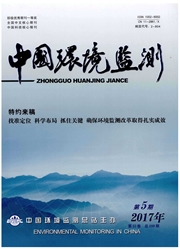

 中文摘要:
中文摘要:
在APEC会议期间和会期之后,分别采集北京、天津、石家庄、保定、济南5个采样点的PM2.5样品,通过分析碳组分的变化特征,研究京津冀地区污染物减排的影响以及减排后各指标的变化特征,分析大气颗粒物中碳气溶胶的可能来源。采用重量法测定组分中PM2.5的含量,利用热/光碳分析仪测定组分中OC、EC的含量,结果表明,由于采取了污染源减排措施,会议期间PM2.5、OC、EC的质量浓度均低于会期之后;会议期间和会期之后OC与EC均表现出了较好的相关性,r2为0.789~0.983,说明OC与EC的排放源基本相同;会议期间OC/EC为3.11~3.62,表明含碳气溶胶的来源主要是机动车排放,同时也存在一定的燃煤排放,会期之后为3.08~6.10,表明燃煤的排放在碳气溶胶中的比重明显增加,另外OC/EC也表明APEC会议期间和会期之后二次有机碳在各采样点均普遍存在。
 英文摘要:
英文摘要:
During the APEC and post-conference, PM2.5 components were collected separately in 5 sampling points located in Beijing, Tianjin, Shijiazhuang, Baoding and Jinan. PM25 of components was tested by gravimetric Method; OC and EC was tested by carbon analyzer. The influenced on PM25 , OC, EC of pollutants emission reduction in Beijing-Tianjin-Hebei Region was studied, and the possible source of carbonaceous aerosol in particles were analyzed. Results showed that during APEC conference, due to significant decreased of pollutants emission in above region, concentration of PM25 , OC and EC was lower than post-conference data. There was correlation of OC and EC during and post conference with r2 0. 789-0. 983, which indicated that same emission source of OC and EC. During conference, the ratio of OC/EC was 3.11-3.62, which indicated that source of carbonaceous aerosol was mainly vehicle exhaust emissions and some coal emission. After conference, the ratio of OC/EC was 3.08-6.10, which indicated that the ratio of coal emission significantly increased. The ratio of OC/EC also indicated that secondary organic carbon was commonly existed in each sampling points during the APEC.
 同期刊论文项目
同期刊论文项目
 同项目期刊论文
同项目期刊论文
 期刊信息
期刊信息
